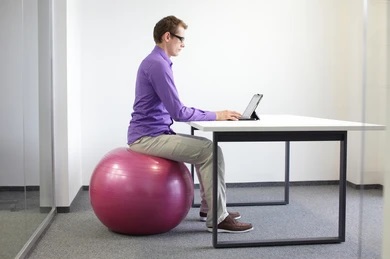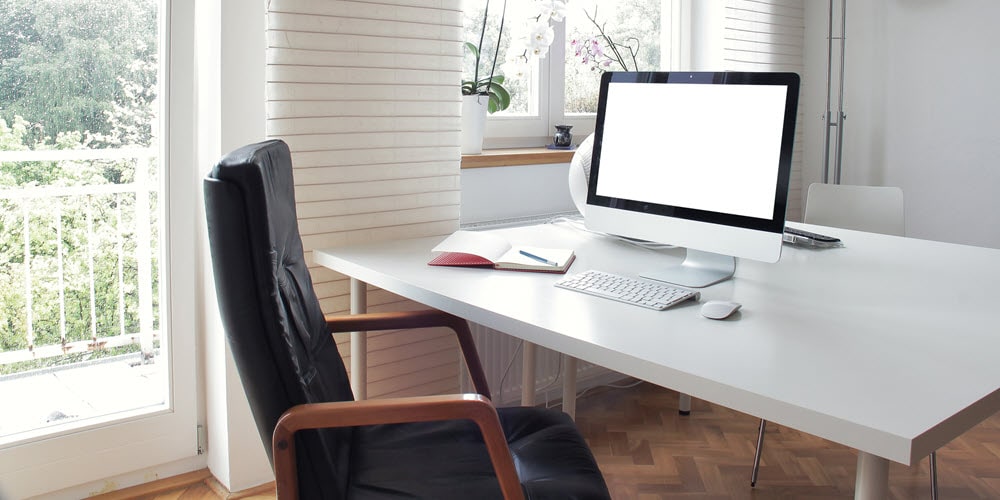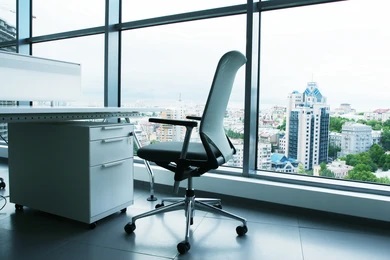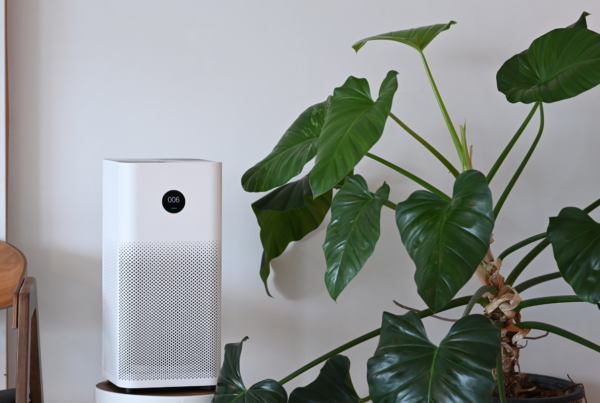The above picture has been taken from Shutterstock’s “ergonomic office” pictures. However, it doesn’t quite fulfill the ergonomic standard of an office. The picture below has been taken from the same search term, but sitting on an exercise ball is far from being an ergonomic and sustainable work habit. So what counts as an ergonomic workstation? In this article, we reveal the scopes that earn your workstation the ergonomic label.

What does ergonomic workspace mean?
Ergonomics is literally defined as the laws of work. One of its main pillars is human factors, which itself is defined as the interaction between humans and the systems we work in. We can say that for a workspace to be ergonomic, it should cater for the needs and capacities of the worker, rather than the latter forcefully adapting to the system and its processes.
What are the characteristics of an ergonomic workspace?
To consider a workspace or workstation ergonomic, it should take into consideration the scopes of ergonomics pertaining to office and computer work. Think of it as a checklist that your workspace has to fulfill. Spoiler alert: it’s not as overwhelming and expensive as one might initially think. The image below is a workstation of our design that costs less than a heavily marketed ergonomic chair.

Furniture design
The first and biggest scope you want to account for your workstation to pass as ergonomic is the furniture design.
Since we are discussing computer workstations, your furniture will consist of the chair and desk. These should be your heaviest investment as they consist the platform that you are working on and the framework of your computer work. Think of your chair and desk as your own skeleton. They hold and support all your tasks, so you don’t want to treat them poorly.
That being said, you don’t have to spend big on your furniture. For example, the chair and desk in the picture above cost less than 1000AED (272USD) combined.
Ergonomic chairs are labelled so not because of a certain material quality, as much as the range of adjustments that you can do with them to fit your comfortable sitting postures and work habits. We discussed the characteristics of an ergonomic chair here and what to search for if you want to buy the best ergonomic chair here.
Ergonomic desks are slightly more expensive to find. A sturdy and height-adjustable desk costs a minimum of 500AED (136USD), which is still worth the investment given that it would cater exactly to your comfortable sitting arrangement that would prevent excessive pressure on your forearms if the desk is relatively high or neck strain if you have to bend your neck for prolonged hours to be able to view the screen.
Workspace environment

This scope may be the hardest to fulfill and in many cases, you may just have to accept reality and work around it. Having an ergonomic office environment means that you have sufficient natural light, proper ventilation, comfortable space, reduced noise, adequate temperature, and pleasant scenery.
Natural light may be one of the hardest factors to obtain in expensive cities, since it’s one of the factors that drives the rent up. However, having a natural source of light can improve productivity and reduce eye strain. If that’s not possible, avoid having office lamps with direct contact to your eyes, since the increased glare can cause eye strains and headaches. Having a strong floor lamp that doesn’t project directly at your eyes is best. Cozy yellow lighting is more comfortable to the eye than bright white lights, so take these factors into consideration as well.


Ventilation is a more straightforward aspect and there is not much to say about it. It may be a challenge in home offices especially after the first lockdown where you probably had to improvise a workstation, but this shouldn’t be negotiable wherever you work.
Room temperature is also a more straightforward aspect with some range for preferences. 20-25 degrees Celsius is the OSHA guideline for room temperature, with humidity 20-60% humidity.
As for the space, you need to make sure that you aren’t stuck in a very small cubicle or room, which can reduce your creativity and productivity. The space goes hand in hand with the scenery: greenery and calming colors are an important asset of an office space.
Noise reduction can be achieved by installing acoustic solutions and by having dedicated Zoom rooms and printing rooms. Machines that produce noise such as printers are better placed in closed rooms or in the office kitchen too if a dedicated room is not possible.
Tools and equipment
Typical tools and equipment used in computer workstations include, but are not limited to, the keyboard, mouse, phone, paper documents, stationary, document holder, and cabinet. You may want to invest in ergonomic options of the tools that you use the most only, but even that is not always necessary based on the body of research currently available. Tools and just that, they are tools that serve a purpose. You don’t have to invest in expensive alternatives that are labelled ergonomics, unless your current tools are causing musculoskeletal pain. Ergonomic tools and equipment are more accurately labelled as alternative tools, because they are designed as a one size fits all, which defies the essence of ergonomics and human factors.
If your tasks involve a lot of clicking, it would make sense to invest in an ergonomic mouse. Same goes for typing and an alternative keyboard, but it’s important to consider that any novel tool you’re going to purchase will require some training time to adapt to it, which will temporarily reduce your efficiency using it.
That being said, if your job includes a lot of talking over the phone and audio/video conferences, a headset can save you a lot of neck and shoulder strain and keep both hands available to perform other tasks if necessary, so consider that investment as a priority.
Overwhelmed?
This article is meant to provide the main guidelines of what defines the main aspects of ergonomic workstations. However, ideal guidelines are provided so that even if you were able to apply 80% of them without leaving health hazards that can seriously harm you, you would still be successful at establishing a safe and user-friendly workspace. If you feel like you need more support at applying ergonomic standards and guidelines practically and affordable, click the link at the bottom right of the screen to book your free consultation where we assess your current needs and work habits to and provide you a customized intervention plan.
Discover more from WellFit
Subscribe to get the latest posts sent to your email.



